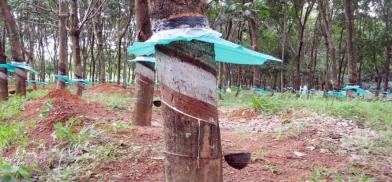South Asia’s rubber farmers hit hard by COVID-19
From Bangladesh to India and to Sri Lanka, the natural rubbers producers are getting squeezed under lockdowns and social distancing. It is sounding the death knell of the region’s rubber economy, writes K S Nayar for South Asia Monitor

Rubber farmers in South Asia have reached the end of their tether. Adverse weather, crippling market uncertainties and rising labour costs have been gnawing away at their earnings. With COVID-19 hammering the rubber economy, even the ‘new normal’ presents a bleak picture before the natural rubber (NR) producers who have been providing livelihood for millions of people.
From Bangladesh to India and to Sri Lanka, the NR producers are getting squeezed under lockdowns and social distancing. It is sounding the death knell of the region’s rubber economy. Amid the slump in the global economy, most farmers have put on hold tapping.
India is the sixth largest NR producing country. It is facing the brunt of market fluctuations and rising labour costs like other five top rubber producers such as Thailand, Indonesia, Vietnam, China and Cote d’Ivoire. In order to sustain, farmers have been trying out intercropping to lessen their dependence on rubber.
“The COVID-19 pandemic has impacted the natural rubber industry in multiple ways,” says Jom Jacob, Senior Economist with the Kuala Lumpur-based 13-member inter-governmental body, the Association of Natural Rubber Producing Countries (ANRPC).
Among the member nations of ANRPC, which account for about 89 per cent of the global NR production, are South Asian countries India, Sri Lanka and Bangladesh. They produce almost 6.5 per cent of the total production of the grouping.
COVID-19 has impacted production, primary processing and local trading of NR in three major ways, Jacob said in an interview. Following a slump in prices, a large number of farmers have put on hold harvesting and stopped maintaining the plantations.
The NR sector is facing disruption under lockdowns, social distancing and widespread shutdowns. Harvesting, primary processing and transportation have been hit.
“Adding to the woes is the abrupt drop in NR demand both in the domestic and international markets,” Jacob said. Factories that used to produce block rubber and centrifuged latex – most of them in the small-scale sector – had slashed purchases following lacklustre market.
ANRPC has now revised down the world NR production outlook for 2020 to 13.433 million tonnes, down 2.3 percent from the previous year. The revised figure is 679,000 tonnes, lower as compared to the outlook presented a month ago, which was 14.112 million tonnes at 2.2 percent growth.
What should concern South Asia’s rubber farmers is the projected fall in NR demand with consumption dropping by 5.1 percent to 13.016 million tonnes from the previous year.
“The revised figure is 516,000 tonnes lower compared to the outlook that we had anticipated a month ago, which was 13.532 million tonnes at minus 1.5 percent growth,” says the economist.
However, the demand pattern shows that there now appears an additional demand for NR from glove and rubber-based healthcare product manufacturers, especially in major producing countries such as Malaysia and Thailand.
“The demand from such manufacturing industries is partly offsetting the fall in NR demand from the automobile and tyre sectors,” he points out.
What is worrying Jacob is the impact on the economy and employment due to the fall in NR production of 3.6 per cent, year-over-year, during the first quarter – January-March or Q1 2020 of the current year.
In this context, he estimates that in the first half of the year (H1 2020), the annualised anticipated fall could be as much as 6.4 per cent. There are also reports that farmers have begun reducing or stopping harvesting.
Jacob says that in India, following the lockdown, tapping activities have been hit, although in some areas restrictions on harvesting have been lifted but only under pandemic protocols.
However, regular tapping has not come back to normal, particularly in the light of unattractive prices, a lack of demand from local traders, and absence of migrant tappers.
In Kerala, which produces 80 percent of India’s NR output, there is an estimated drop of 50,000 tonnes in production due to lockdowns. However, thanks to a surge in demand from glove and rubber-based healthcare product makers, latex processing is now being allowed. Dislocation of workers and supply-chain disruptions still affect normal factory operations.
In the high-risk pandemic zones of Sri Lanka, which produces 0.6 percent of NR among the ANRPC grouping, harvesting, processing, and local trading in the produce are facing disruption following the lockdowns.
Since the first week of April, farmers, especially smallholders, have been hurt very badly following accumulation of NR stocks due to poor demand from end-users.
The outlook on worldwide NR consumption has been scaled down in the light of global economic contraction. It is estimated that consumption has fallen 20.0 percent, year-over-year, during Q1 2020 and it is anticipated to fall 15.5 percent, year-over-year, during H1 2020.
The pandemic has removed almost 516,000 tonnes of NR from the world demand in 2020. The automobile and tyre industry, which constituted 75 percent of the global NR demand, is stuttering. And there is no sign of its quick revival.
For South Asian rubber growers, COVID-19 pandemic has hit them so badly that the mostly smallholders are in the throes of an economic squeeze from which they can hope to recover only when the global economy gains growth momentum. And it may take three to four years or even more.
(The writer is Senior Fellow, SPS. He can be contacted at ksnayar@spsindia.in)










Post a Comment